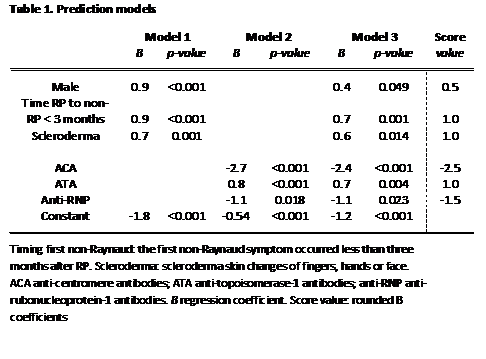Session Information
Date: Monday, November 9, 2015
Title: Systemic Sclerosis, Fibrosing Syndromes and Raynaud's - Clinical Aspects and Therapeutics Poster II
Session Type: ACR Poster Session B
Session Time: 9:00AM-11:00AM
ABSTRACT
Background/Purpose:
Diffuse cutaneous
systemic sclerosis (dcSSc) is associated with a poorer prognosis compared to
limited cutaneous SSc (lcSSc), due to earlier and more severe organ involvement
(1). Early recognition of dcSSc patients is
advantageous to apply timely screening or treatment. Possibly, differences
between dcSSc and dcSSc in the early course of disease may be useful for early
differentiation of subtypes. To determine whether the timing of both Raynaud’s
phenomenon (RP) and the first non-Raynaud (non-RP) symptom and the type of the
first non-RP symptom, combined with disease specific auto-antibodies are
predictive for the development of dcSSc or lcSSc.
Methods: The Nijmegen Systemic Sclerosis cohort consists of prospectively
followed SSc patients. Demographic s, data about RP and the first non-RP
symptom, and disease specific auto-antibodies were collected at first
presentation, patients were followed up at least 1 year after diagnosis to
confirm subtype of SSc. Univariate and multivariate logistic regression was
used for predictive modeling. Performance was analyzed using discrimination and
calibration, in an external cohort of 445 SSc patients from Madrid.
Results: A total of 553 SSc patients were included, 176 (31%) was
classified as dcSSc. Time between RP and the first non-RP symptom differed
between dcSSc and lcSSc (0.0 vs. 0.4 years; p<0.001). Puffy fingers (37%)
and scleroderma (22%) were the most common first non-RP symptoms. The final
prediction model had an area under the ROC curve of 0.79 (95% CI 0.75-0.83), a
sensitivity of 87% and a specificity of 61%. External validation of this model
showed a sensitivity of 78% (95% CI 0.74-0.83) and a specificity of 65%. A
simple scoring method was created, with a cut point indicative for dcSSc.
Conclusion: This study presents a simple scoring method to improve
recognition of patients prone to development of dcSSc. The easy accessible
items in the model will help clinicians to recognize patients prone to dcSSc,
who are expected to have a poorer prognosis.
1. Steen VD, Medsger TA, Jr. Severe organ involvement in systemic sclerosis with diffuse
scleroderma. Arthritis Rheum. 2000;43(11):2437-44.
To cite this abstract in AMA style:
van den Hombergh W, Knaapen-Hans H, Carreira PE, van den Hoogen F, Fransen J, Vonk M. Early Signs, Symptoms and Auto-Antibodies to Predict Diffuse Cutaneous or Limited Cutaneous Systemic Sclerosis at First Presentation [abstract]. Arthritis Rheumatol. 2015; 67 (suppl 10). https://acrabstracts.org/abstract/early-signs-symptoms-and-auto-antibodies-to-predict-diffuse-cutaneous-or-limited-cutaneous-systemic-sclerosis-at-first-presentation/. Accessed .« Back to 2015 ACR/ARHP Annual Meeting
ACR Meeting Abstracts - https://acrabstracts.org/abstract/early-signs-symptoms-and-auto-antibodies-to-predict-diffuse-cutaneous-or-limited-cutaneous-systemic-sclerosis-at-first-presentation/

